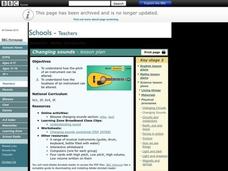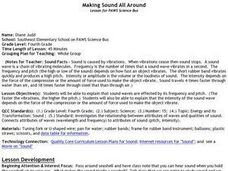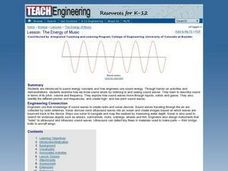Science 4 Inquiry
Musical Vibes with Palm Pipes
Ancient people used musical pipes as early as the third millennium BCE. Young scientists explore the workings of musical pipes to better understand the relationship with frequency, length of pipe, and sound waves. They determine the...
Curated OER
Tune Up Your Ears!
Students discuss meaning of pitch, listen for different sounds in classroom, hallway, and outdoors, and listen to sounds played on piano and on computer to determine high or low pitch.
Curated OER
Musical Mountain
Students listen to low, middle, and high pitches of music and identify if they are low, middle, or high. In this musical pitch lesson plan, students visually see low, middle, and high pitches on a mountain.
Curated OER
Changing Sounds
Students listen to sound. In this changing sounds instructional activity, students play instruments to help them hear volume and pitch. Students use the interactive whiteboard to experiment how change can make sounds go higher or lower.
Curated OER
Animal Challenge 2
In this pitch instructional activity, students examine a list of 6 animals. Students record the size of each animal as big or small and the sounds they make as high or low.
Curated OER
Vibrating Objects Produce Sound
Students use many different materials and resources in order to study and identify sounds that are loud or soft, high or low, pleasant or unpleasant.
Urbana School District
Sound
Beautiful music doesn't just write itself, but if you ever feel bad about procrastinating, remember that Mozart wrote the overture to Don Giovanni the morning it premiered. Introduce young scientists to the elements of sound including...
Perkins School for the Blind
Modified Kickball
Kickball is a classic recess game that everybody should play at least once. Included here is a wonderful set of instructions that describe how you can modify the game to make it accessible to children with low or no visual ability....
Curated OER
Small and Tall
Students demonstrate pitch direction by using movement and visual representation.
Curated OER
Music Elements For Second Grade
Second graders are exposed to a variety of attributes of melody in seven lessons of this unit. the notation in treble clef, pitch, and the movements of the melody are presented in these lessons.
Curated OER
Making Sound All Around
Fourth graders examine how sound waves are effected by frequency and pitch. They conduct experiments using tuning forks, rubber bands, balloons, and water, and answer questions about the experiments.
Curated OER
Elements of Music
In this music worksheet, 7th graders fill in the blanks in 7 sentences that describe the elements of music such as tempo, pitch, decay, and duration. They use the words from a word bank at the bottom of the page. They make a word search...
San Francisco Symphony
The American Five - Pentatonic scales in early American melodies
Through vocal warm-ups and exercises, budding musicians will attempt to grasp the five pentatonic scales, commonly used in early American songs. They'll sing and work to identify the pitch, tone, melody, and scales being expressed in the...
Curated OER
Sound Observations
Students explore sound waves by conducting an experiment in class. In this sound frequency instructional activity, students utilize a tuning fork in class and identify which objects in class create different sound pitches on the fork....
Curated OER
Sizing Up Sound
Sixth graders are introduced to the concepts of sound waves and frequency. As a class, they listen to the differences between different types of instruments. To end the lesson, they practice identifying low and high pitches and playing...
Curated OER
What is Sound?
Second graders discuss sound and describe them. In this investigative lesson plan students observe sound through their eyes, bodies and ears.
Curated OER
Upward and Downward Motion of Melody
First graders explore the notion of upward and downward melody motion. They hum, sing, and listen as the melody moves up and down. To show what they know, they put their thumbs up or down as the melody shifts.
Curated OER
Allegro Band Warm-Up & Joyance rehearsal
In need of a high school band lesson? This resource includes a warm up, objectives for learners to focus on, and notes for each part of the song being played. These notes are specific to the learners it is written for, but may give you...
Curated OER
The Choir
In this music worksheet, students read an excerpt about the choir, the oldest of all musical groups. They identify that human voices vary in pitch, some high and some low, making it possible to sing harmonies in different layers.
Curated OER
The Sorcerer's Apprentice
Third graders listen to "The Sorcerer's Apprentice". Using the music, they identify the high and low parts in the orchestal composition. They compare the elements of a story to the piece of music and respond to the music and state how...
Curated OER
Musical Instruments - Woodwinds
Young scholars assemble and examine typical European orchestral woodwind instruments, determine how the instruments change pitch, identify common orchestral woodwind instruments by sound, and research a non-Euro-centric woodwind...
Curated OER
The Energy of Music
Students discover how engineers use sound energy. They participate in hands-on activities in which they discover how we know sound exists. They identify different pitches and frequencies as well.
Curated OER
Sound
In this sound worksheet, students understand how sound is created and how the human ear "hears." Students compare the frequency, amplitude, and speed of sound. Then students complete 10 matching, 7 fill in the blank, and 11 short answer...
Curated OER
How Low Can You Go?
Students are introduced to the concepts of elevation and slopes. Using Minneapolis and St. Paul, they graph elevation of various cities in a scenerio given to them. They also calculate the total miles traveled and organize the...

























